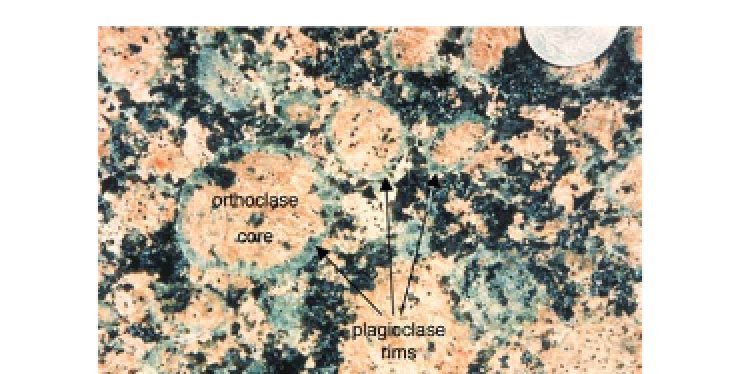Geology Reference
In-Depth Information
Figure 7.23
Rapakivi granite texture with corroded megacrysts of K-feldspar
(pink) mantled by greyish plagioclase. (Courtesy of Robin Gill).
same granitic material in which the orbs are embedded. The thicknesses and
mineral contents of the layers forming different shells of the orbicules are often
similar, suggesting that they grew together. This may have happened during
rhythmic crystallisation, analogous to that responsible for igneous lamination
(Sections 2.4.2 and 8.2), with the difference that, instead of resulting from crys-
tal settling, the orbicules accreted available crystals from the magma before final
consolidation of leucocratic material in the interstices took place.
Rapakivi granite
(Figure 7.23) contains large phenocrysts (several centimetres
long) of alkali feldspar, often salmon pink or flesh-coloured, mantled by a rim
(1 - 2 mm thick) of white plagioclase feldspar. These complex phenocrysts are
usually embedded in a groundmass of quartz, feldspars, biotite and/or amphibole.
Often the alkali feldspars are rounded, unlike most phenocrysts in igneous rocks
which are euhedral, possibly indicating corrosion or remelting of their edges
into the magma before crystallisation of the plagioclase rim. Rapakivi texture is
most common in alkali granites (Chapter 9), notably the type localities in south
Finland, but is also found in some calc-alkaline types and as decoration on many
building walls.
7.8 Metamorphic Aureoles
This brief section on metamorphic aureoles is included here because aureoles are
best developed around granitoid (granodiorite and granite) intrusions emplaced
within a few kilometres of the Earth's surface, where there is liable to be a
marked contrast between the temperature of the intrusion (circa 700 - 1000
◦
C)
and the country rocks (
200
◦
C). Aureoles reflecting metamorphism in the tem-
perature range 200 - 700
◦
C are characteristically up to 2 - 3 km wide around
<

















